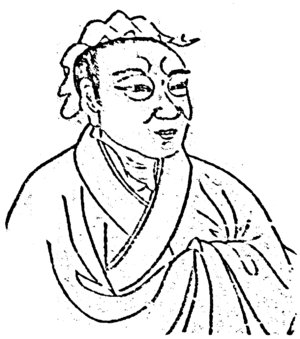Sima Qian facts for kids
Quick facts for kids
Sima Qian
|
|
|---|---|
 |
|
| Born | c. 145 or 135 BC Longmen, Han Empire (now Hejin, Shanxi)
|
| Died | c. 86 BC (after 91 BC) |
| Occupation | Astrologer, historian, poet |
| Known for | Records of the Grand Historian |
| Relatives | Sima Tan (father) |
Sima Qian (born around 145 BC, died around 86 BC) was a famous Chinese historian. He lived during the early Han dynasty, a powerful time in ancient China. Many people call him the "father of Chinese history writing" because of his amazing book, Records of the Grand Historian.
This book tells the story of China for over 2,000 years! It starts with the legendary Yellow Emperor and goes all the way to Emperor Wu of Han, who ruled when Sima Qian was alive. Even though he is best known for his history book, Sima Qian was also a talented poet and writer.
Contents
Sima Qian's Early Life and Learning
Sima Qian was born in a place called Xiayang, which is now part of Shaanxi Province in China. He was probably born around 145 BC, but some say it was closer to 135 BC.
When Sima Qian was about nine years old, his father, Sima Tan, got an important job. His father became the "grand historian" (tàishǐ). This job was not very high-ranking, but it was important. The grand historian's main job was to create the yearly calendar for the emperor. They also traveled with the emperor for special events and wrote down daily happenings at court and across the country. Sima Qian himself said that by age ten, he could "read the old writings." This showed he was a very promising student.
Around 126 BC, when Sima Qian was about twenty, he began a long journey. He traveled all over China, exploring the different parts of the Han dynasty.
Working for the Emperor
After his travels, Sima Qian was chosen to work for the government as a Palace Attendant. His job was to travel with Emperor Wu and check on different parts of the country. This happened around 122 BC. Sima Qian got married when he was young and had one daughter.
In 110 BC, when he was thirty-five, Sima Qian was sent on a military trip. He went west to fight against some tribes. That same year, his father became very ill. His father called Sima Qian home and asked him to finish the history book he had started. Inspired by his father, Sima Qian spent the next ten years writing and putting together the Records of the Grand Historian.
Three years after his father passed away, Sima Qian took over his father's old job as taishi. In 105 BC, Sima Qian was part of a group of scholars chosen to improve the calendar. As a senior official, he also gave advice to the emperor on important matters of the state.
Writing the Records of the Grand Historian
A Difficult Time for Sima Qian
In 99 BC, Sima Qian faced a very tough situation. Two army officers, Li Ling and Li Guangli, led a fight against a northern group called the Xiongnu. They were defeated and captured. Emperor Wu blamed Li Ling for the loss, and all the government officials spoke against him.
Sima Qian was the only person who defended Li Ling. Li Ling was not his friend, but Sima Qian respected him. Emperor Wu saw Sima Qian's defense of Li Ling as an attack on his own brother-in-law, Li Guangli. Because of this, Emperor Wu sent Sima Qian to prison.
Later Years and Legacy
After being released from prison around 97/96 BC, Sima Qian continued to work for the Han court. He served as a court archivist, which meant he kept important records.
Historians believe Sima Qian spent his last days as a quiet scholar after leaving the Han court. He might have passed away around the same time as Emperor Wu, in 87/86 BC.
Sima Qian as an Astronomer
Both Sima Qian and his father held the position of taishi (太史) in the Han Dynasty. This job was more than just being a historian. It also included being a court writer, a calendar maker, and a court astronomer or astrologer.
Back then, the astrologer had a very important role. They were in charge of understanding and predicting how the government would run based on the Sun, Moon, and stars. They also watched for other natural events like solar eclipses and earthquakes. To do this, they had to keep the calendar very accurate.
Sima Qian helped create the Taichu Calendar in 104 BC. This calendar was a new version of an older one. It was the first Chinese calendar where all the details of how it was calculated were saved.
A small planet, "12620 Simaqian," is named after him to honor his work.
Images for kids
See also
 In Spanish: Sima Qian para niños
In Spanish: Sima Qian para niños



